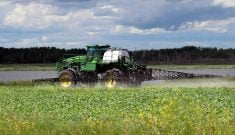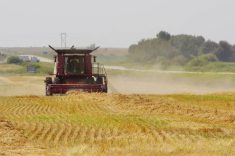Maximum residue limits can affect the marketability of a crop, so farmers need to heed them, say crop market experts.
“Because we produce so much beyond what we need for our domestic demand for food, we really do need to keep in mind market access and those requirements that we see with our export partners,” said Krista Zuzak, director of crop protection and production for Cereals Canada.
Why it matters: Non-compliance with regulations on pesticide residue can be traced back to the farm and can result in fines.
Read Also

Journal pulls long-cited glyphosate study for ethics violations
The journal Regulatory Toxicology and Pharmacology has retracted a 2000 Monsanto-linked glyphosate review, drawing new scrutiny as Bayer faces mounting legal pressure.
Zuzak was part of an online panel discussion sponsored by Keep It Clean, which offered pre-harvest tips to help farmers remain compliant with MRLs and other factors that can affect market access.
She was joined by Greg Bartley, Pulse Canada’s director of crop protection and crop quality, and Ian Epp, an agronomy specialist with the Canola Council of Canada.
Keep It Clean is a joint initiative of the Canola Council of Canada, Cereals Canada, Pulse Canada and the Prairie Oat Growers Association, and is mandated to provide tools and timely updates on chemistry-based market access risks.
“The Keep It Clean program provides resources for on-farm best practices and focuses on how we can meet those standards for both domestic and export customers,” said Zuzak.
The program is structured around five principles:
- Only acceptable pesticides: Keepitclean.ca offers an annual product advisory list (updated at the end of April) that lists products that are off limits.
- The label is king: Read and follow the label before applying any crop protection product. Information should include application rate, timing, and pre-harvest interval, the minimum amount of time between the last application of a pesticide and when the crop can be harvested.
- Manage disease pressures: Outside of yield protection, weeds can bring market access issues that must be considered.
- Proper crop storage: Proper storage helps maintain crop quality and keeps the bulk free of harmful cross-contaminants. Storage bins should be checked regularly to ensure they’re kept cool, dry and well ventilated.
- Deliver what you declare: The Declaration of Eligibility affidavit is a legally binding document, and any incorrect information, intentional or unintentional, can be traced back to the farm and individuals held liable for the costs associated with the contamination of a bin or shipment.
Notes for pulses
Chlorothalonil is a late-season fungicide for chickpea growers and a hurdle for crops bound for the European Union.
“The EU has revoked these MRLs for chlorothalonil. If you’re using this late season, go talk to your buyer, make sure that they’re aware you’re using the product and make sure there are no marketing concerns,” said Bartley.
Glufosinate ammonium, likewise “has been on the advisory for a long time, and for good reason,” Bartley noted. “In Western Canada, if you do use this product on lentils, it will cause non-compliance.”
There is also the subject of pre-harvest glyphosate, although growers will likely run into the domestic threshold before it becomes a concern for trade.
“When we look at all of our major markets, the glyphosate MRLs are typically at a level that’s higher than the Canadian MRLs right now,” said Bartley.
Nevertheless, he warned that there is still a marketing risk due to consumer perception and the possibility of regulatory change.
“It’s worth a conversation with the grain buyer, just make sure there are no restrictions,” he said.
Notes for canola
As far as pre-harvest glyphosate in canola, “if we apply it correctly, it’s an excellent tool,” said Epp. “But there’s a heck of a lot of scrutiny under this product globally.”
Epp noted the importance of timing. Pre-harvest glyphosate may only be applied when grain moisture content is less than 30 per cent in the greenest part of the field.
“In canola, that’s 50 to 60 per cent seed colour change,” he said. “Getting that right and really scouting those green parts can be challenging.
“Top seeds are green and firm to roll, the middle ones are mostly brown with some speckling and the bottom ones are completely brown to black,” Epp noted. “Pods can look dramatically different, either riper or less ripe, than the actual seeds, so we need to be cracking open those pods and looking at the seeds.”
Other harvest and market access considerations for canola include pre-harvest scouting for blackleg.
“While you’re in the field swathing and spraying your glyphosate at 60 per cent seed colour change, pull the plants and look for the blackleg. You want to pull at least 50 plants. You want to look at a variety you know throughout the field,” Epp said.
Judging blackleg levels can guide any decisions to switch varieties the next time canola is planted in that field.
“Good planning can make this disease a lot easier to manage,” said Epp.
Notes for cereals
For late season applications of glyphosate, Zuzak said cereals should first reach 30 per cent moisture. She suggested using the thumbnail test.
“You apply pressure to a grain kernel with your thumbnail, and you’re looking for how the imprint reacts,” she said. “If the imprint remains in the kernel, it’s at that hard dough stage and it’s ready for a pre-harvest glyphosate application, but if it springs back, this is telling you that your moisture is too high.”
Zuzak said wheat, barley and oats may be accepted if they’re treated with pre-harvest glyphosate, but it’s important to check with a grain buyer before making the decision to spray.
The exception is malt barley, which will not be accepted by grain buyers if sprayed with pre-harvest glyphosate.
Chlormequat, known by its trade name Manipulator, also warrants a call to the buyer, according to Zuzak, and buyers won’t accept malt barley treated with saflufenacil.
“This one doesn’t originate so much from an MRL issue. The reason for restricting saflufenacil on malt barley has to do with negative impacts on the malting process,” she said.
Zuzak reiterated the importance of reading and following the label because “we really want to keep that market access open for all of our crops.”
















